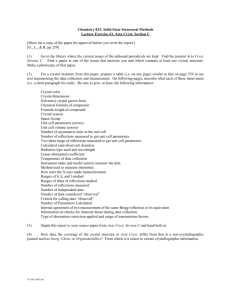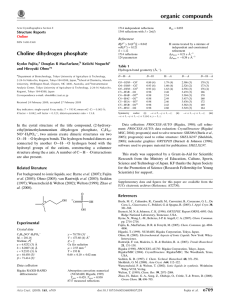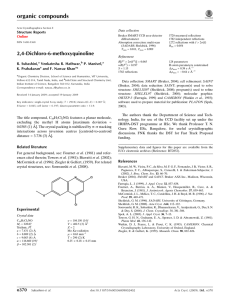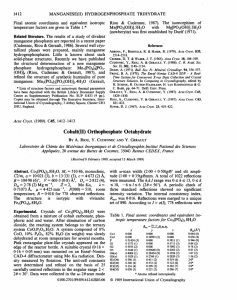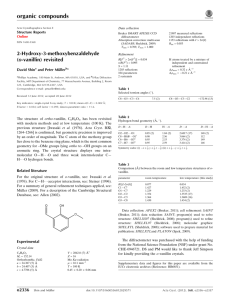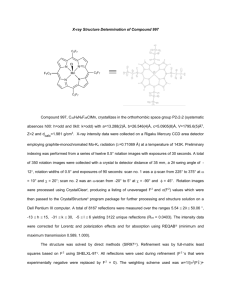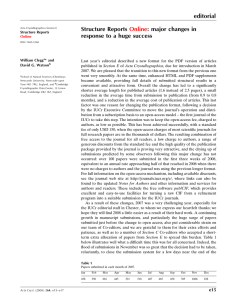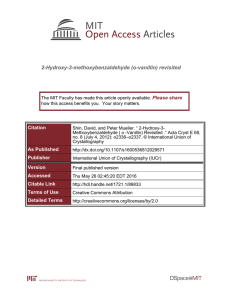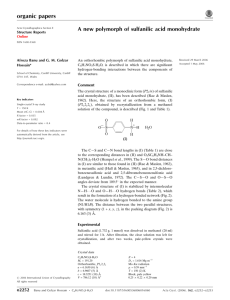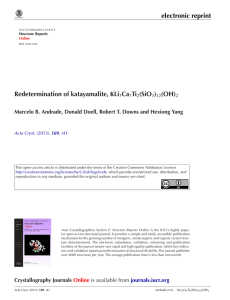Ethyl 4-chloro-3,5
advertisement
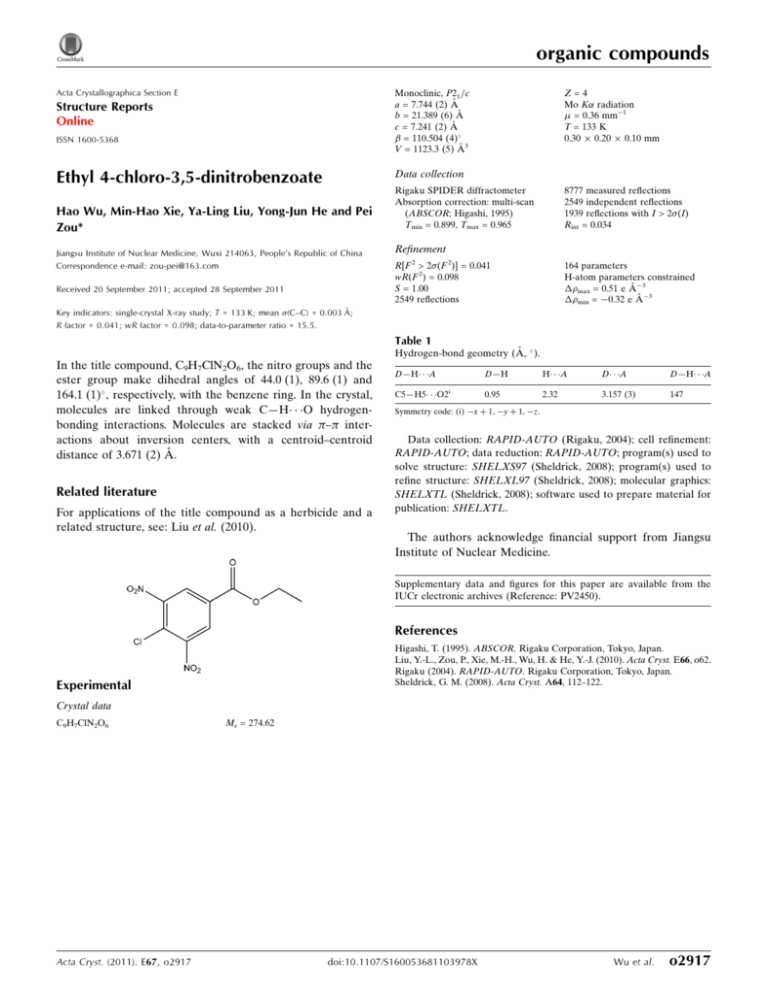
organic compounds Acta Crystallographica Section E Monoclinic, P21 =c a = 7.744 (2) Å b = 21.389 (6) Å c = 7.241 (2) Å = 110.504 (4) V = 1123.3 (5) Å3 Structure Reports Online ISSN 1600-5368 Z=4 Mo K radiation = 0.36 mm1 T = 133 K 0.30 0.20 0.10 mm Data collection Ethyl 4-chloro-3,5-dinitrobenzoate Hao Wu, Min-Hao Xie, Ya-Ling Liu, Yong-Jun He and Pei Zou* Jiangsu Institute of Nuclear Medicine, Wuxi 214063, People’s Republic of China Correspondence e-mail: zou-pei@163.com Received 20 September 2011; accepted 28 September 2011 Rigaku SPIDER diffractometer Absorption correction: multi-scan (ABSCOR; Higashi, 1995) Tmin = 0.899, Tmax = 0.965 8777 measured reflections 2549 independent reflections 1939 reflections with I > 2(I) Rint = 0.034 Refinement R[F 2 > 2(F 2)] = 0.041 wR(F 2) = 0.098 S = 1.00 2549 reflections 164 parameters H-atom parameters constrained max = 0.51 e Å3 min = 0.32 e Å3 Key indicators: single-crystal X-ray study; T = 133 K; mean (C–C) = 0.003 Å; R factor = 0.041; wR factor = 0.098; data-to-parameter ratio = 15.5. Table 1 Hydrogen-bond geometry (Å, ). In the title compound, C9H7ClN2O6, the nitro groups and the ester group make dihedral angles of 44.0 (1), 89.6 (1) and 164.1 (1) , respectively, with the benzene ring. In the crystal, molecules are linked through weak C—H O hydrogenbonding interactions. Molecules are stacked via – interactions about inversion centers, with a centroid–centroid distance of 3.671 (2) Å. Related literature For applications of the title compound as a herbicide and a related structure, see: Liu et al. (2010). D—H A C5—H5 O2 i D—H H A D A D—H A 0.95 2.32 3.157 (3) 147 Symmetry code: (i) x þ 1; y þ 1; z. Data collection: RAPID-AUTO (Rigaku, 2004); cell refinement: RAPID-AUTO; data reduction: RAPID-AUTO; program(s) used to solve structure: SHELXS97 (Sheldrick, 2008); program(s) used to refine structure: SHELXL97 (Sheldrick, 2008); molecular graphics: SHELXTL (Sheldrick, 2008); software used to prepare material for publication: SHELXTL. The authors acknowledge financial support from Jiangsu Institute of Nuclear Medicine. Supplementary data and figures for this paper are available from the IUCr electronic archives (Reference: PV2450). References Higashi, T. (1995). ABSCOR. Rigaku Corporation, Tokyo, Japan. Liu, Y.-L., Zou, P., Xie, M.-H., Wu, H. & He, Y.-J. (2010). Acta Cryst. E66, o62. Rigaku (2004). RAPID-AUTO. Rigaku Corporation, Tokyo, Japan. Sheldrick, G. M. (2008). Acta Cryst. A64, 112–122. Experimental Crystal data C9H7ClN2O6 Acta Cryst. (2011). E67, o2917 Mr = 274.62 doi:10.1107/S160053681103978X Wu et al. o2917 supporting information supporting information Acta Cryst. (2011). E67, o2917 [doi:10.1107/S160053681103978X] Ethyl 4-chloro-3,5-dinitrobenzoate Hao Wu, Min-Hao Xie, Ya-Ling Liu, Yong-Jun He and Pei Zou S1. Comment The title compound is useful as a herbicide (Liu et al., 2010). In the title molecule (Fig. 1), two nitro groups (O3/N1/O4 and O5/N2/O6) attached at C2 and C4 and the ester group (O1/C7/O2) attached at C6 form dihedral angles of 44.0 (1), 89.6 (1) and 164.1 (1)°, respectively, with the mean plane of the benzene ring (C1–C6). In the cyrstal structure, the molecules are linked through weak C—H···O hydrogen bonding interactions. The molecules are stacked via π-π interactions, about inversion centers with the ring centroid-centroid distance of 3.671 (2) Å. S2. Experimental A sample of commercial ethyl 4-chloro-3,5-dinitrobenzoate (Aldrich) was crystalized by slow evaporation of a solution in methanol yielding colorless chunky crystals after several days. S3. Refinement H atoms were placed in calculated positions with C—H = 0.99, 0.98 or 0.95 Å for methylene, methyl or aryl type Hatoms, respectively, and were refined in a riding mode with Uiso(H) = 1.2 or 1.5Ueq(C). Figure 1 A view of the title compound with the atomic numbering scheme. Displacement ellipsoids were drawn at the 50% probability level. Acta Cryst. (2011). E67, o2917 sup-1 supporting information Figure 2 Part of the packing of the title compound, viewed down the c direction; dashed lines indicate hydrogen bonds. Ethyl 4-chloro-3,5-dinitrobenzoate Crystal data C9H7ClN2O6 Mr = 274.62 Monoclinic, P21/c Hall symbol: -P 2ybc a = 7.744 (2) Å b = 21.389 (6) Å c = 7.241 (2) Å β = 110.504 (4)° V = 1123.3 (5) Å3 Z=4 F(000) = 560 Dx = 1.624 Mg m−3 Melting point: 357(2) K Mo Kα radiation, λ = 0.71073 Å Cell parameters from 2718 reflections θ = 3.2–27.5° µ = 0.36 mm−1 T = 133 K Block, colorless 0.30 × 0.20 × 0.10 mm Data collection Rigaku SPIDER diffractometer Radiation source: Rotating Anode Graphite monochromator ω scans Absorption correction: multi-scan (ABSCOR; Higashi, 1995) Tmin = 0.899, Tmax = 0.965 8777 measured reflections 2549 independent reflections 1939 reflections with I > 2σ(I) Rint = 0.034 θmax = 27.5°, θmin = 3.8° h = −8→10 k = −27→27 l = −9→9 Refinement Refinement on F2 Least-squares matrix: full R[F2 > 2σ(F2)] = 0.041 wR(F2) = 0.098 S = 1.00 2549 reflections 164 parameters 0 restraints Primary atom site location: structure-invariant direct methods Acta Cryst. (2011). E67, o2917 Secondary atom site location: difference Fourier map Hydrogen site location: inferred from neighbouring sites H-atom parameters constrained w = 1/[σ2(Fo2) + (0.0496P)2 + 0.269P] where P = (Fo2 + 2Fc2)/3 (Δ/σ)max < 0.001 Δρmax = 0.51 e Å−3 Δρmin = −0.32 e Å−3 sup-2 supporting information Special details Geometry. All e.s.d.'s (except the e.s.d. in the dihedral angle between two l.s. planes) are estimated using the full covariance matrix. The cell e.s.d.'s are taken into account individually in the estimation of e.s.d.'s in distances, angles and torsion angles; correlations between e.s.d.'s in cell parameters are only used when they are defined by crystal symmetry. An approximate (isotropic) treatment of cell e.s.d.'s is used for estimating e.s.d.'s involving l.s. planes. Refinement. Refinement of F2 against ALL reflections. The weighted R-factor wR and goodness of fit S are based on F2, conventional R-factors R are based on F, with F set to zero for negative F2. The threshold expression of F2 > σ(F2) is used only for calculating R-factors(gt) etc. and is not relevant to the choice of reflections for refinement. R-factors based on F2 are statistically about twice as large as those based on F, and R- factors based on ALL data will be even larger. Fractional atomic coordinates and isotropic or equivalent isotropic displacement parameters (Å2) Cl1 O1 O2 O3 O4 O5 O6 N1 N2 C1 H1 C2 C3 C4 C5 H5 C6 C7 C8 H8A H8B C9 H9A H9B H9C x y z Uiso*/Ueq 0.66615 (7) 0.82698 (18) 0.6015 (2) 0.82102 (19) 0.9456 (2) 0.3393 (3) 0.5882 (3) 0.8513 (2) 0.5021 (3) 0.7812 (2) 0.8417 0.7714 (2) 0.6846 (2) 0.6034 (2) 0.6100 (3) 0.5530 0.7015 (2) 0.7039 (2) 0.8358 (3) 0.9010 0.7101 0.9385 (3) 1.0599 0.9540 0.8689 0.68101 (2) 0.39122 (6) 0.41837 (6) 0.51915 (7) 0.60842 (7) 0.65336 (10) 0.68236 (8) 0.56285 (8) 0.64949 (8) 0.49987 (8) 0.4660 0.55765 (8) 0.60877 (8) 0.59805 (8) 0.54110 (8) 0.5357 0.49173 (8) 0.43024 (8) 0.32869 (8) 0.3303 0.3121 0.28811 (10) 0.3064 0.2463 0.2851 0.67393 (8) 0.43011 (19) 0.14870 (19) 1.00581 (19) 0.9835 (2) 0.2213 (3) 0.1760 (3) 0.9112 (2) 0.2496 (2) 0.6145 (3) 0.6966 0.6956 (3) 0.5805 (3) 0.3785 (3) 0.2923 (3) 0.1539 0.4111 (3) 0.3140 (3) 0.3507 (3) 0.2551 0.2829 0.5225 (3) 0.5927 0.4752 0.6121 0.02902 (15) 0.0229 (3) 0.0283 (3) 0.0269 (3) 0.0402 (4) 0.0610 (6) 0.0562 (6) 0.0237 (4) 0.0286 (4) 0.0172 (4) 0.021* 0.0177 (4) 0.0189 (4) 0.0194 (4) 0.0194 (4) 0.023* 0.0166 (4) 0.0178 (4) 0.0232 (4) 0.028* 0.028* 0.0317 (5) 0.048* 0.048* 0.048* Atomic displacement parameters (Å2) Cl1 O1 O2 O3 O4 O5 O6 U11 U22 U33 U12 U13 U23 0.0369 (3) 0.0279 (8) 0.0401 (9) 0.0299 (8) 0.0530 (10) 0.0495 (12) 0.0571 (12) 0.0164 (2) 0.0157 (6) 0.0187 (7) 0.0321 (8) 0.0306 (9) 0.0778 (15) 0.0344 (10) 0.0335 (3) 0.0196 (7) 0.0173 (7) 0.0197 (7) 0.0267 (8) 0.0620 (13) 0.0572 (12) 0.0007 (2) 0.0058 (5) 0.0037 (6) 0.0041 (6) −0.0122 (7) 0.0438 (10) −0.0177 (8) 0.0121 (2) 0.0016 (6) −0.0012 (6) 0.0102 (6) 0.0010 (7) 0.0275 (10) −0.0049 (9) −0.00696 (19) −0.0021 (5) −0.0029 (5) 0.0041 (6) −0.0100 (6) 0.0343 (11) 0.0259 (9) Acta Cryst. (2011). E67, o2917 sup-3 supporting information N1 N2 C1 C2 C3 C4 C5 C6 C7 C8 C9 0.0249 (9) 0.0392 (11) 0.0177 (9) 0.0189 (10) 0.0194 (10) 0.0211 (10) 0.0224 (10) 0.0180 (9) 0.0210 (10) 0.0300 (11) 0.0426 (13) 0.0255 (9) 0.0175 (9) 0.0149 (8) 0.0195 (9) 0.0146 (9) 0.0151 (9) 0.0180 (9) 0.0146 (8) 0.0153 (9) 0.0140 (9) 0.0225 (11) 0.0190 (8) 0.0226 (9) 0.0176 (9) 0.0140 (9) 0.0233 (9) 0.0211 (9) 0.0164 (9) 0.0172 (8) 0.0179 (9) 0.0230 (10) 0.0285 (11) 0.0027 (7) 0.0054 (8) 0.0010 (7) −0.0019 (7) −0.0019 (7) 0.0026 (7) 0.0001 (7) −0.0006 (7) 0.0010 (7) 0.0032 (8) 0.0077 (9) 0.0058 (7) 0.0027 (8) 0.0046 (7) 0.0048 (7) 0.0081 (8) 0.0063 (8) 0.0051 (8) 0.0062 (7) 0.0077 (8) 0.0062 (8) 0.0104 (10) −0.0032 (7) 0.0015 (7) 0.0016 (7) −0.0009 (7) −0.0029 (7) 0.0042 (7) 0.0015 (7) −0.0001 (7) 0.0017 (7) −0.0029 (7) 0.0031 (8) Geometric parameters (Å, º) Cl1—C3 O1—C7 O1—C8 O2—C7 O3—N1 O4—N1 O5—N2 O6—N2 N1—C2 N2—C4 C1—C2 C1—C6 C1—H1 1.7125 (19) 1.323 (2) 1.467 (2) 1.209 (2) 1.229 (2) 1.220 (2) 1.207 (2) 1.213 (2) 1.468 (2) 1.478 (2) 1.382 (2) 1.394 (2) 0.9500 C2—C3 C3—C4 C4—C5 C5—C6 C5—H5 C6—C7 C8—C9 C8—H8A C8—H8B C9—H9A C9—H9B C9—H9C 1.396 (3) 1.394 (3) 1.378 (3) 1.389 (2) 0.9500 1.495 (2) 1.497 (3) 0.9900 0.9900 0.9800 0.9800 0.9800 C7—O1—C8 O4—N1—O3 O4—N1—C2 O3—N1—C2 O5—N2—O6 O5—N2—C4 O6—N2—C4 C2—C1—C6 C2—C1—H1 C6—C1—H1 C1—C2—C3 C1—C2—N1 C3—C2—N1 C4—C3—C2 C4—C3—Cl1 C2—C3—Cl1 C5—C4—C3 C5—C4—N2 C3—C4—N2 C4—C5—C6 116.64 (14) 124.79 (17) 118.86 (16) 116.32 (16) 126.00 (19) 116.76 (18) 117.18 (18) 119.39 (16) 120.3 120.3 122.25 (17) 117.00 (16) 120.72 (16) 116.31 (16) 119.57 (14) 124.07 (15) 123.11 (17) 117.89 (17) 118.99 (16) 118.89 (17) C4—C5—H5 C6—C5—H5 C5—C6—C1 C5—C6—C7 C1—C6—C7 O2—C7—O1 O2—C7—C6 O1—C7—C6 O1—C8—C9 O1—C8—H8A C9—C8—H8A O1—C8—H8B C9—C8—H8B H8A—C8—H8B C8—C9—H9A C8—C9—H9B H9A—C9—H9B C8—C9—H9C H9A—C9—H9C H9B—C9—H9C 120.6 120.6 120.02 (16) 117.72 (16) 122.22 (16) 124.99 (17) 122.60 (16) 112.40 (15) 106.70 (16) 110.4 110.4 110.4 110.4 108.6 109.5 109.5 109.5 109.5 109.5 109.5 Acta Cryst. (2011). E67, o2917 sup-4 supporting information C6—C1—C2—C3 C6—C1—C2—N1 O4—N1—C2—C1 O3—N1—C2—C1 O4—N1—C2—C3 O3—N1—C2—C3 C1—C2—C3—C4 N1—C2—C3—C4 C1—C2—C3—Cl1 N1—C2—C3—Cl1 C2—C3—C4—C5 Cl1—C3—C4—C5 C2—C3—C4—N2 Cl1—C3—C4—N2 O5—N2—C4—C5 O6—N2—C4—C5 −0.3 (3) 177.67 (16) 136.26 (18) −41.8 (2) −45.8 (3) 136.14 (17) 1.6 (3) −176.24 (16) 179.17 (14) 1.3 (3) −1.5 (3) −179.18 (15) 177.30 (17) −0.4 (2) 88.2 (2) −89.0 (2) O5—N2—C4—C3 O6—N2—C4—C3 C3—C4—C5—C6 N2—C4—C5—C6 C4—C5—C6—C1 C4—C5—C6—C7 C2—C1—C6—C5 C2—C1—C6—C7 C8—O1—C7—O2 C8—O1—C7—C6 C5—C6—C7—O2 C1—C6—C7—O2 C5—C6—C7—O1 C1—C6—C7—O1 C7—O1—C8—C9 −90.7 (2) 92.1 (2) 0.1 (3) −178.79 (17) 1.4 (3) 179.03 (16) −1.3 (3) −178.82 (16) −1.0 (3) 177.99 (15) −15.2 (3) 162.35 (18) 165.76 (16) −16.6 (2) −163.27 (17) Hydrogen-bond geometry (Å, º) D—H···A C5—H5···O2 i D—H H···A D···A D—H···A 0.95 2.32 3.157 (3) 147 Symmetry code: (i) −x+1, −y+1, −z. Acta Cryst. (2011). E67, o2917 sup-5
